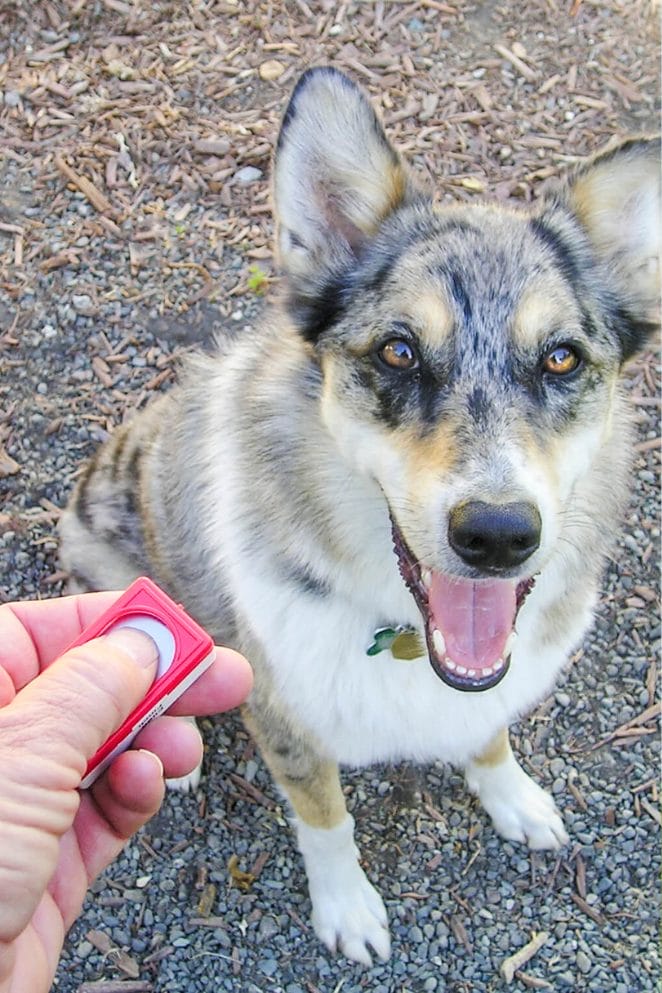
Clicker training is one of the most popular methods for teaching dogs obedience. But why clicker training is bad for dogs?
On the surface, it can seem like a great way to interact with your pup and reward them for good behavior. But there are a few major downsides when it comes to this type of training.
Let’s understand more about this training method.
What is clicker training?
Clicker training is a type of positive reinforcement dog training that uses the sound of a clicker as an additional way to communicate with your pup.
The sound of the clicker acts as a marker, telling your dog precisely when they’ve done something right and are due for a reward.
The basic idea behind this type of training is that it reinforces desirable behaviors and extinguishes unwanted ones through reward-based learning.
But this training has a downside too. Let’s explore more about it.
Why clicker training is bad for dogs

Clicker training is an increasingly popular method of dog training, but it’s not without its faults. In fact, there are plenty of reasons why can it be detrimental to your pup.
Here are 10 important points to consider when evaluating whether or not it is right for you and your canine companion:
1. Reinforces unwanted behaviors:
As with all positive reinforcement methods, clicker training can inadvertently reinforce unwanted behaviors if used incorrectly.
For instance, if a click isn’t issued quickly enough after the desired behavior has been performed, the dog may interpret this as being a reward for an undesired action and repeat it in the future.
This means that if you don’t time the clicks correctly, you may actually end up rewarding the very behaviors that you are trying to eliminate.
2. It may cause stress:
The loud sound of the clicker can be startling and stressful for some dogs, especially those with sensitive hearing or a history of trauma.
For these dogs, even if used correctly and humanely, it may cause additional stress rather than alleviate it.
3. It can lead to physical injuries:
If not done properly and slowly, your pup might end up getting hurt during training sessions due to overexertion or excessive repetition of certain exercises.
Additionally, clicking too close to the dog’s face can cause facial injury due to flinching in reaction to the sound or sudden movement.
This is especially true with dogs who have a history of physical abuse or dominance-based training methods.
4. It doesn’t address underlying behaviors:
While clicker training can help get rid of unwanted behaviors, it doesn’t address the root cause of why they are happening in the first place.
Therefore, if the underlying issue isn’t addressed, those behaviors may continue to resurface no matter how much you use them.
5. It can lead to dependence on rewards:

If used too heavily, clicker training can lead to an unhealthy reliance on rewards for every positive behavior and action that your dog performs.
This means that your pup might become less likely to do something without expecting a reward in return.
6. Clicker training can lead to over-excitement:
If used excessively and without proper guidance, clicker training can lead to a dog becoming over-excited or hyperactive when the sound of the clicker is heard.
This could make it difficult for your pup to focus and learn effectively during training sessions.
7. It can’t replace concrete commands:
While clicker training can be an effective way to teach certain behaviors, it’s not ideal for conveying more complex commands such as “sit” or “down” which need to be said with clarity and precision for your pup to understand them.
8. It is time-consuming:
For owners who are short on time, clicker training may not be the best option as it often requires more patience and repetition than other methods of dog training.
9. Clicker training can make your dog more anxious:
If used incorrectly or without proper guidance, it can cause your pup to become anxious due to incorrect timing or lack of clarity in commands.
Anxious dog breeds would be more prone to this.
This means that your pup might end up being even more stressed out than before. This could lead to further behavioral issues down the line.
10. Requires a consistent environment:
Clicker training needs a consistent environment with minimal distractions in order to be effective.
Therefore, it’s important to make sure that you create an environment where their focus can be maintained throughout the session.
Overall, this is not ideal for every dog or situation and should only be used by experienced trainers who understand the proper usage of the tool and are comfortable adjusting their approach as needed.
Additionally, if you do decide to use this method of training, it’s important to monitor your pup closely and adjust accordingly if they become overly anxious or distressed during a session.
With consistent care and attention from an experienced trainer, clicker training can be an effective way to positively reinforce certain behaviors in dogs.
However, for those owners who are looking for a more traditional form of obedience-based training, then clicker training may not be the best option.
Conclusion

Clicker training might seem like a fun, easy way to train your pup, but it’s often more harmful than helpful. It not only teaches dogs the wrong behavior but can also cause them distress if not done correctly.
There are plenty of better alternatives, such as reward-based training that focuses on positive reinforcement and treats.
You can also try basic obedience classes. Spend more quality time with your dog by playing together and teaching commands.
The bottom line is that while clicker training may be an easier route for you, it’s not necessarily the best one for your pup!
So remember, when it comes to teaching your furry friend some new tricks, always think of their best interests first.


GIPHY App Key not set. Please check settings